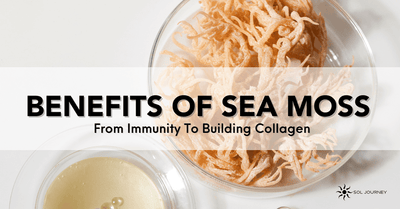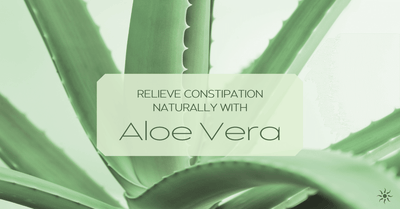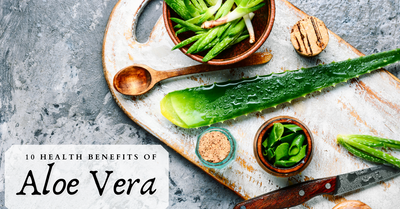Why Aloe Vera Was The Ancient Egyptian 'Plant of Immortality'

We all know the aloe vera plant for its healing ability. From acne to skin burns, this wondrous plant has properties that no other plant has.
But are you aware of the plant’s history? How far back does it go?
The aloe vera plant has quite a long history. And according to historians, it started with the Egyptians over 6,000 years ago. They called it the “plant of immortality”.
In this post, we’ll explore what the aloe vera plant is, its history with the ancient Egyptians, and its medicinal benefits.
What Is Aloe Vera?

Aloe vera, or Aloe barbadensis, is a succulent plant with very short stems and thick leaves. It’s one of 420 plants in the genus Aloe. So, there are many types of Aloes.
However, there’s only one true Aloe Barbadensis. The aloe vera plant thrives in tropical, semi-tropical, and arid climates around the world.
There’s speculation that the plant originated in the Arabian Peninsula. Eventually, it reached most warm regions across Africa, the Middle East, and the Mediterranean.
Now, most languages have a word for aloe vera, and farmers grow the plant on every continent.
Characteristics of Aloe
The leaves in the aloe vera plant contain a slimy tissue that stores water, which is what makes the leaves thick. This slimy water-filled tissue is what we know as aloe vera gel.
The gel contains most of the aloe vera plant’s beneficial nutrients, including antioxidants, vitamins, minerals, enzymes, amino acids, and salicylic acid.
But there’s another useful part of the plant: aloe latex. Aloe latex is the juice that seeps from the aloe vera plant when you cut it. It’s yellow in color, has a bitter taste, and has strong laxative properties.
Uses of Aloe
A wide range of manufacturers and brands cultivate aloe vera for commercial products, mainly as a topical treatment. Manufacturers also use it in beverages, skin lotions, cosmetics, ointments, and gels.
Timeline
Let’s look at a brief timeline of the aloe vera plant.
- 2100 BC: A record of the plant’s benefits appear on a Mesopotamian tablet.
- 1550 BC: An Egyptian text describes aloe vera’s medicinal benefits and provides instructions on how to use it for both internal and external symptoms.
- 70 AD: The Greeks use aloe vera to treat wounds, hair loss, and other issues.
- 1655: First mention of aloe vera in the English language.
- 1820: The U.S. Pharmacopeia claims people can use aloe vera to protect the skin.
- 1930s: Physicians begin to use aloe vera to treat radiation dermatitis.
- Today: People in many countries use aloe vera for topical and internal uses.
The History of Aloe Vera in Ancient Egypt

The ancient Egyptians called the aloe vera plant the “plant of immortality”. They elevated the plant to a god-like status.
Egyptians regarded aloe as the sacred plant of the “blood”, which held the secrets to beauty, health, and longevity.
Egyptians placed such a high value on aloe vera that they used it to measure a person’s wealth. The amount of aloe, in pounds, a man brought as an offering to the deceased pharaohs showed his wealth.
The Egyptians used aloe vera for a wide range of purposes, such as treating burns, healing wounds, and reducing fever.
The Papyrus Ebers, an Egyptian document from circa 1550 B.C, is the first detailed written record of aloe vera’s medicinal value.
There are also records of the Egyptians drawing pictures of aloe vera plants on the walls of the temples.
Egyptian queens such as Nefertiti and Cleopatra used the plant for beauty, while others used it as a funeral gift for pharaohs.
They embalmed the dead with aloe vera because of its antibacterial and antifungal properties.
Egyptians believed that if they could stop or at least slow down the body’s decomposition process, they could obtain eternal life -- both on a spiritual and physical level.
Ancient Egypt, the Third Eye, and the Pineal Gland

You might be familiar with the famous Egyptian symbol that depicts the “third eye”.. You might also know other terms describing the third eye as the “Eye of Horus” or the “all-seeing eye”.
Well, the Egyptians noticed that it looked a lot like the pineal gland within the brain.
Egyptians saw the third eye as the gateway of spiritual life and a place that holds the.potential for each human to attain enlightenment and consciousness. They also saw the third eye as a symbol representing protection, health, and restoration.
So what does this have to do with aloe vera?
Let’s explore a study that looked at pineal indole melatonin (MLT) therapy and its role in activating anticancer immunity and how immunomodulating substances (stimulate the immune system) from aloe vera can enhance the effect.
Melatonin is a hormone that’s important for sleep and may also play a role in modifying immunity, the stress response, and certain aspects of the aging process. One of the key functions of the pineal gland is to secrete melatonin.
The study found that aloe vera may enhance the therapeutic results of MLT in patients with advanced solid tumors.
Here are the findings in more detail.
Patients who received MLT plus aloe achieved a higher incidence of stable disease (12/24 patients) compared to patients who received MLT alone (7/26 patients).
So, what does this mean?
That aloe vera can help the pineal gland produce more melatonin, which can help fight diseases like cancer and slow the aging process.
So, maybe the Egyptians were onto something when it comes to the aloe vera plant of immortality.
How Aloe Spread Around the World
Over time, aloe vera’s ability to grow in a variety of climates made it possible to produce the plant around the world.
Many point to the Jesuit priests from Spain as the people who introduced the plant to the New World.
Aloe Vera in the Modern Day
It wasn’t until the 1960s and 70s that the new market for aloe vera began to expand. With better technology, manufacturers were better able to process the plant’s inner gel and mass produce it for commercial use.
Today, modern research shows aloe vera’s beneficial healing properties, from helping stomach acid to moisturizing the skin.
Let’s take a look at some of the beneficial properties this amazing plant has to offer.
Medicinal Properties of Aloe Vera

So why did the Egyptians swear by aloe vera? What “magical” ingredients does it contain that made them hold it in such high regard?
Let’s take a look.
1. Contains Healthful Plant Compounds
Aloe vera contains vitamins, minerals, amino acids, and antioxidants.
- Vitamins and antioxidants: Vitamins A, C, and E are important for ridding the skin of free radicals before they cause damage. Free radicals can contribute to cancer, heart disease, and other illnesses. Antioxidants are also helpful in fighting inflammation. Aloe vera contains B vitamins as well, which have a wide range of functions, from preventing anemia to stimulating appetite.
- Minerals: Calcium, sodium, iron, magnesium, potassium, and copper are important minerals for maintaining overall health.
- Amino acids: Aloe vera contains 20 0f 22 existing amino acids, which are hugely important for forming proteins.
2. Has Antioxidant and Antibacterial Properties
The antioxidants within aloe vera are beneficial to health. These antioxidants help control the growth of certain bacteria.
Aloe vera also has antibacterial, antiviral, and antiseptic properties. This is why it can help heal wounds and treat skin problems.
3. Contains Other Essential Nutrients
- Sugars: Protect the walls of the stomach, hydrate the tissues, and promote immune system function.
- Enzymes: Help heal wounds and produce an analgesic effect, which aids in pain relief.
- Anthraquinones: Act as a laxative, antimicrobial, and antiinflammatory
- Fatty acids: Have anti-inflammatory properties.
Skin and Health Benefits of Aloe Vera
1. Promotes Heart Health
A study on patients with atheromatous heart disease revealed that aloe vera may help people with high cholesterol levels. It does this by decreasing lipids, which accumulate within arteries. By clearing the arteries, aloe vera can help improve blood circulation, which plays a key role in how the heart functions.
2. Helps the Digestive System
Aloe has a soothing effect on the digestive tract. A group of researchers found that people with GERD who took aloe syrup received significant relief from GERD symptoms.
They also found that aloe’s effectiveness is comparable to drugs that reduce symptoms of GERD.
Another study showed that aloe vera may also be effective in treating stomach ulcers. Aloe vera acts as an anti-inflammatory agent on ulcers.
The researchers believe that the healing effect of aloe is because it increases cytokines that are important for the wound healing process. Cytokines are proteins that signal the immune system to do its job: fight infection and inflammation.
3. Slows Aging
Recent evidence shows that aloe vera stimulates collagen and hyaluronic acid production in the skin.
The same study found that women who ate yogurt that contained aloe gel powder had more moisturized, elastic, and healthy skin than the placebo group.
Aloe vera can also decrease the appearance of fine lines, so it can possibly slow down aging effects.
4. Boosts the Immune System
Aloe vera helps support the immune system. The plant contains an enzyme called bradykinase, which helps stimulate the immune system.
Zinc, a key component for hormone receptors and proteins, is also present in aloe vera. So, bradykinase and zinc combine to protect the body from bacteria, diseases, and cell damage.
Studies show that when consuming the latex of aloe vera, it can boost immune health. Caroline Ingles from Herbalife and other researchers found that latex from aloe vera activates T-lymphocytes and monocytes, cells that play a key role in the immune response.
5. Hydrates the Skin
The aloe plant’s leaf is rich in water, which means it can hydrate the skin and help lock in moisture. The sugars it contains also help moisturize the skin.
When you apply aloe vera topically, it can increase the water content in the outermost layer of your skin, meaning it can be an ideal treatment for dry skin.
6. Lowers Blood Sugar Levels
A meta-analysis, a study that looks at a wide range of literature, showed that people who consumed aloe had lower fasting blood glucose levels.
A meta-analysis, a study that looks at a wide range of literature, showed that people who consumed aloe had lower fasting blood glucose levels. This shows that aloe vera is beneficial for blood sugar and HbA1c support in diabetic and prediabetes.
7. Treats Acne
According to research, when people used aloe vera along with anti-acne medication, they saw a significant improvement in their acne.
Aloe’s anti-inflammatory properties mean that it can help reduce swelling, tenderness, and pain. And because aloe has wound-healing effects, it can help heal acne blemishes.
8. Soothes Burns
In one study, a team of plastic surgeons compared aloe vera to 1 percent silver sulfadiazine (SSD) cream, which helps treat burn wounds.
The study found that for patients who received aloe vera as a topical treatment, their burns healed a lot more quickly compared to patients who received the SSD cream.
Plus, the aloe vera group experienced faster and more significant pain relief than those in the SSD group.
9. Relieves Pain
Aloe vera may be effective in relieving back pain. That’s because it contains a polysaccharide called acemannan.
This ingredient is responsible for aloe vera’s therapeutic benefits, such as its ability to fight inflammation and reduce pain.
Because of its anti-inflammatory properties, aloe vera may be helpful in reducing arthritis pain as well. Applying it to the skin or even taking it by mouth can help with joint pain.
Plus, aloe doesn’t have the negative gastrointestinal issues people experience when taking anti-inflammatory pain relief medications like Ibuprofen, Advil, and Aleve.
Conclusion
The ancient Egyptians were true pioneers of modern medicine. Their use of aloe vera influenced others to start using the plant.
Although aloe vera isn’t a medical treatment, many people are using it to treat various conditions, and in many cases, it’s been pretty effective. What does the future hold for aloe vera?
With many new studies coming along, we’ll learn even more about the ancient Egyptian plant of immortality and its wonderful healing properties.
Read More: The Top Health Benefits Of Aloe Vera










Leave a comment